Are you ready to tackle snowy roads with confidence? Discover the essential guide to effortlessly installing snow chains and mastering winter driving!
How To Install Quick Fit Snow Chains (Overview)
- Practice and Preparation:
- Practice installing chains in a safe area before snowy conditions.
- Determine correct chain placement based on your vehicle’s drivetrain.
- Chain Setup:
- Unpack one chain from each bag.
- Hold chain ends straight and untangled (yellow in left hand, blue in right hand).
- Installing Chains:
- Lay chains behind the tire, starting with the yellow end from back to front.
- Connect yellow and blue ends; attach red hook to gold link.
- Ensure the chain’s center rail aligns with the tire tread’s center.
- Securing Chains:
- Pull the red draw chain tight and secure it using the bungee end.
- Check chain tightness; adjust by moving the red hook across gold chain links.
- Final Adjustments and Safety Tips:
- Move the car forward to settle chains; re-tighten if necessary.
- Drive cautiously, adhering to speed limits and avoiding bare pavement.
In this article, you’ll explore everything you need to know about installing snow chains for your vehicle, including understanding different drivetrains and their impact on chain use, preparing for installation, a step-by-step guide for installation, safety tips while driving with chains for a smoother winter driving experience.

Auto Tightening Snow Chains
Understanding Your Vehicle and Snow Chains
Understanding your vehicle’s drivetrain is important for understanding where to install your snow chains if you only have one set of chains. Proper placement ensures you maximize traction and maintain control when driving through snowy or icy conditions.
It’s best to chains installed on all four tires instead of using only two chains. This will help prevent oversteer or understeer in winter driving conditions.
Here’s a breakdown to help you understand these elements better.
Different Types of Drivetrains and How Snow Chains Work with Them
Cars and trucks come in four main types based on how they drive: rear-wheel drive, front-wheel drive, all-wheel drive (AWD), and four-wheel drive (4WD).
Each type is different and needs snow chains in specific ways:
- Rear-Wheel Drive Vehicles (RWD):
- Vehicles with RWD send power to the back wheels. Putting snow chains on the back wheels helps a lot in snow or ice because it gives better grip when starting or turning.
- You should install chains on the back wheels of RWD cars to help them stay stable when you’re driving in slippery conditions.
- Front-Wheel Drive Vehicles (FWD):
- FWD vehicles send power to the front wheels. Putting snow chains on the front tires helps a FWD car or truck have better grip when you’re driving on snow or ice.
- Chains on the front tires give better control, especially when turning or starting in slippery conditions.
- All-Wheel Drive Vehicles (AWD):
- AWD cars use different ways to send power to all wheels. Usually, you’ll want to put chains on all four tires of an AWD car for good grip and control in snow or icy weather.
- Most AWD cars need chains on all the tires to help them get better traction and control in tough conditions.
- Four-Wheel Drive Vehicles (4WD):
- 4WD cars have different modes for different kinds of roads. Sometimes, they might need snow chains depending on what the manufacturer suggests.
- Like AWD cars, using chains on all the tires might be needed for better grip in snow or ice for 4WD vehicles.
To learn more about the laws about using snow chains in your state, take a look at TireGrades’ guide on tire chain laws by state. Understanding these rules can help you follow the law when driving in snowy places.
Preparing for Snow Chain Installation
There are a few things you should check before installing snow chains to make sure they work well and keep you safe. It’s essential to make sure you have the right ones for your tires and that the road conditions are suitable for using them.
Choosing the Correct Snow Chains for Your Tires
Picking the right snow chains matters. It’s not just about making your tires look good; it’s about making sure your car stays safe and works well in snowy or icy conditions. Here’s what you need to do:
- Check Your Tire Size: Look at your car’s manual or the side of your tire to find the right size for your snow chains. Different tire sizes need different chains.
- Inspect Tire Tread: Make sure your tires have enough tread left. Tread helps your tires grip the road. If your tires are very worn out, snow chains might not work as well.
- Understand Chain Packaging: Snow chains come in different packages. Some might be easier to put on than others. Check the instructions in the packaging to see if they’re clear and easy to follow.
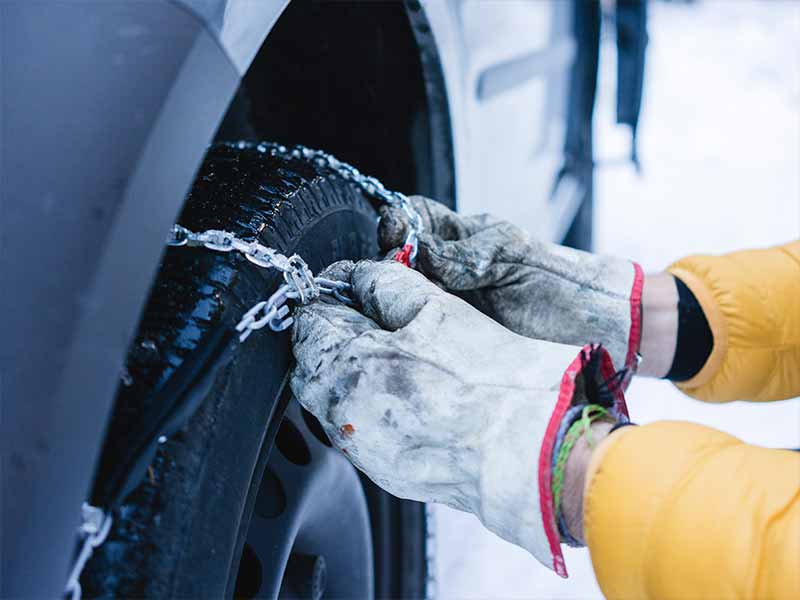
Step-by-Step Guide: Installing Tire Chains
To get more details about the different types of snow chains, cables, and socks, head to TireGrades’ guide comparing snow chains, cables, and socks. Understanding these options can help you choose the best chains for your car when it’s snowy outside.
Knowing how to install tire chains ensures you’re well-prepared for winter driving. Let’s break down the steps to safely install quick-fit chains for your vehicle.
Step 1: Prepare and Test Fit
- Practice First: Before hitting snowy roads, practice installing chains in a safe area.
- Choose the Correct Chain Placement: For front-wheel drive, place chains on the front tires; for rear-wheel drive, on the back. All-wheel drive requires checking the owner’s manual for the right placement.
Step 2: Chain Setup
- Unpack Chains: Open the bag and take out one chain from each bag.
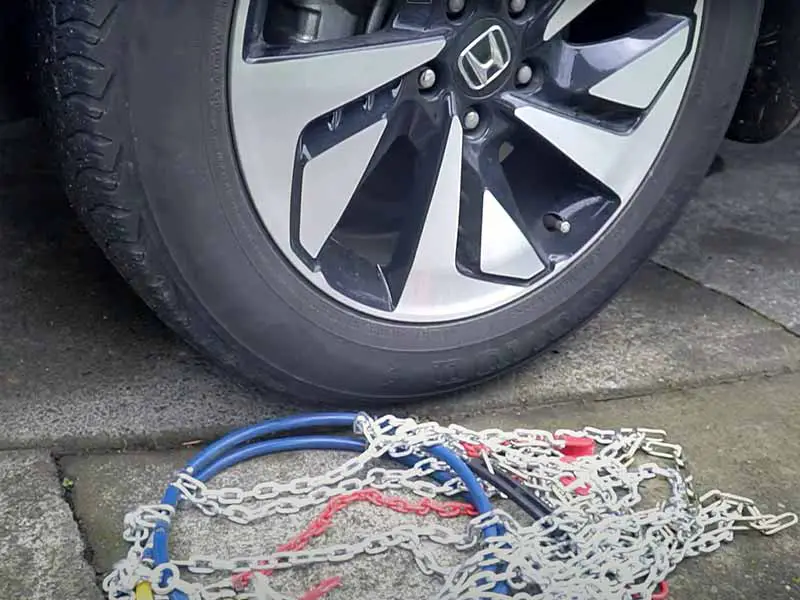
- Chain Orientation: Hold the chain ends (yellow in left hand, blue in right hand) and ensure they’re straight and untangled.
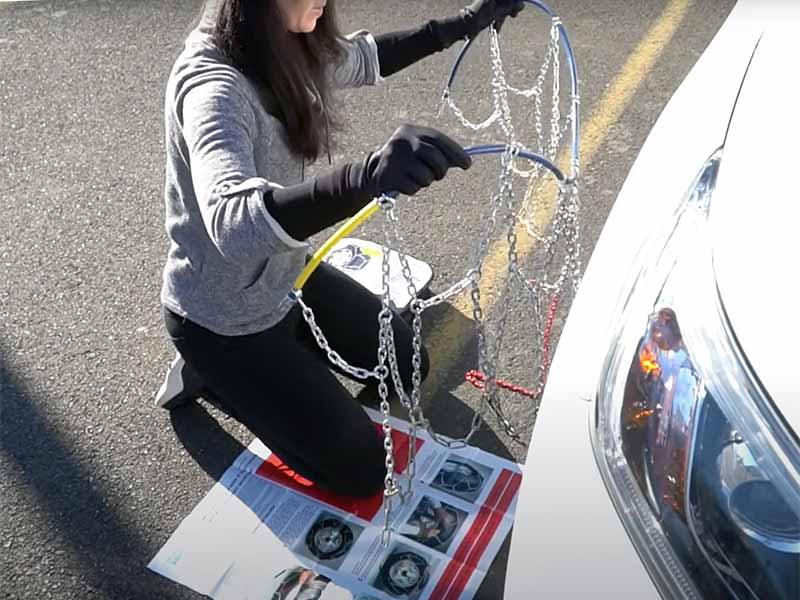
Step 3: Installing Chains
- Placement Behind the Tire: Lay the chains behind the tire, starting with the yellow end from back to front.
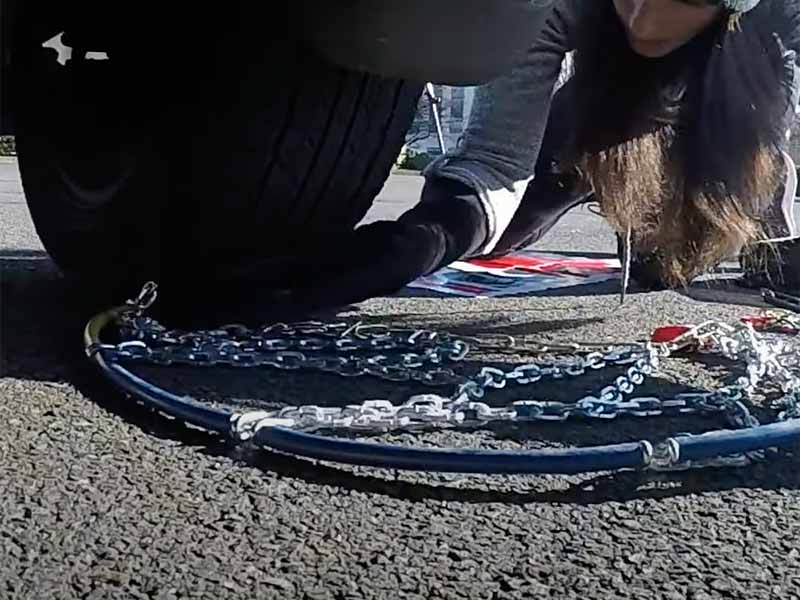
- Connect: Join the yellow and blue ends
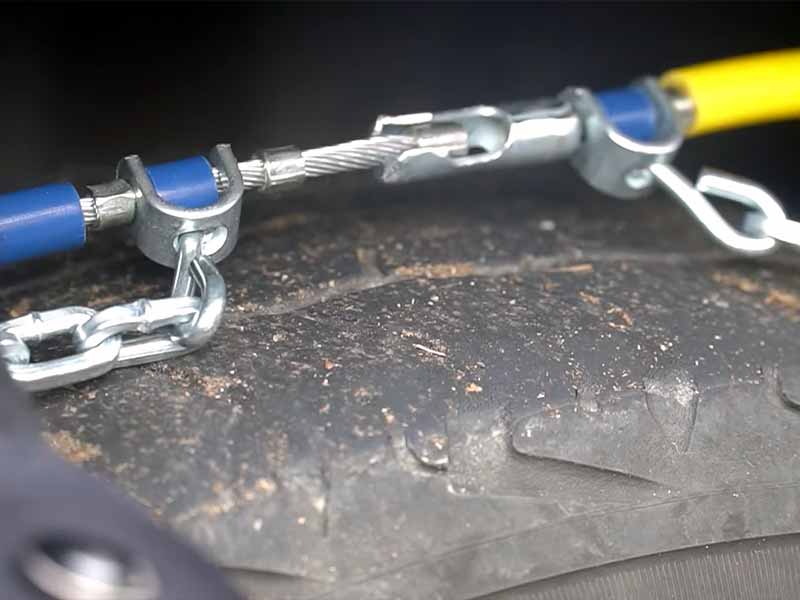
- Hook: then connect the red hook to the gold link.
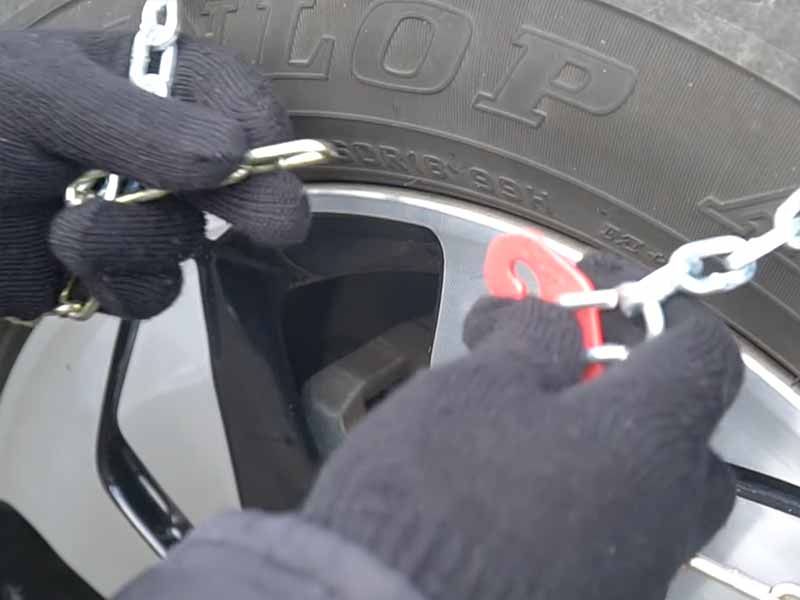
- Center Alignment: Ensure the chain’s center rail aligns with the middle of the tire tread.
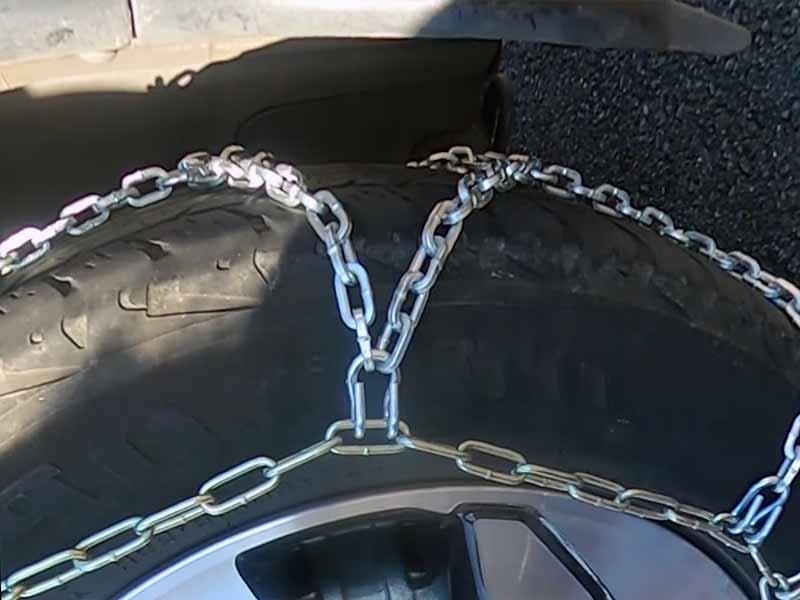
Step 4: Securing Chains
- Adjust the Draw Chain: Pull the red draw chain tight and secure it using the bungee end.
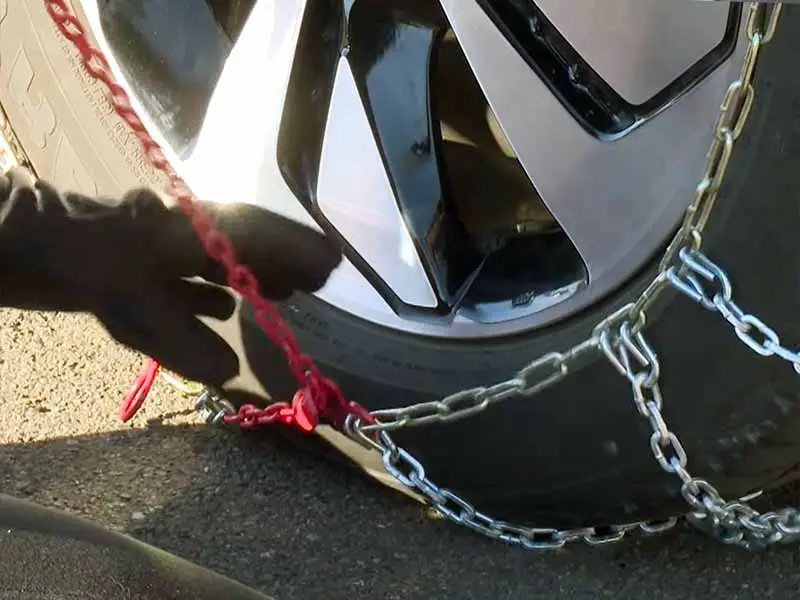
- Proper Alignment: Check the chain’s tightness; adjust if needed by moving the red hook across the gold chain links.
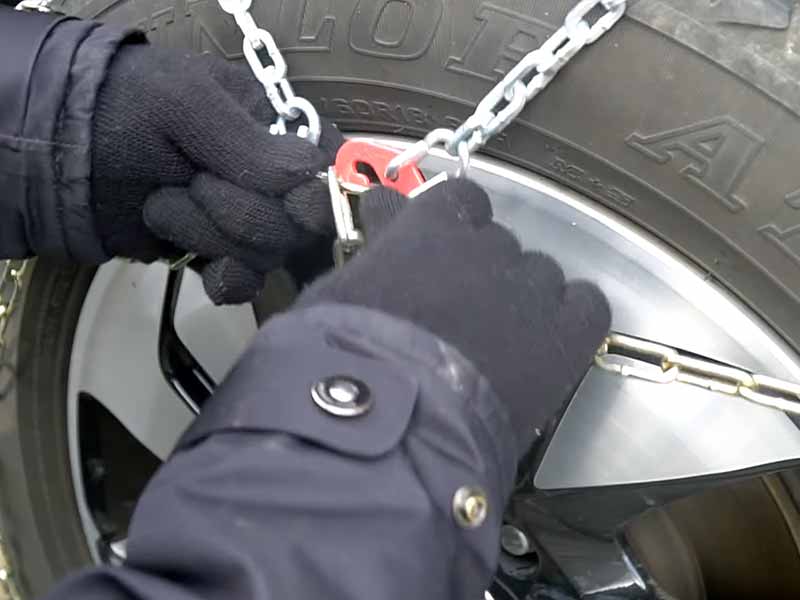
Step 5: Final Adjustments and Safety Tips
- Drive Forward: Move the car forward to settle the chains; re-tighten if necessary.
- Safety Measures: Follow speed limits, avoid driving on bare pavement, and ensure chains are not hitting the vehicle.
- Removal Process: When clear of heavy snow and ice conditions, safely remove chains by unhooking bungee, releasing chain guide, and disconnecting cable connections.
Additional Tips for Maintenance
- Drying the Chains: Lay chains flat to dry to prevent rusting after use.
Installing tire chains ensures better traction and safety in snowy conditions. Remember to drive cautiously and adhere to recommended speeds and road conditions.
For information on how many snow chains you might need for different types of vehicles, check out TireGrades’ guide on the number of snow chains for AWD and 2-wheel drive to help you better understand the right amount for your car.
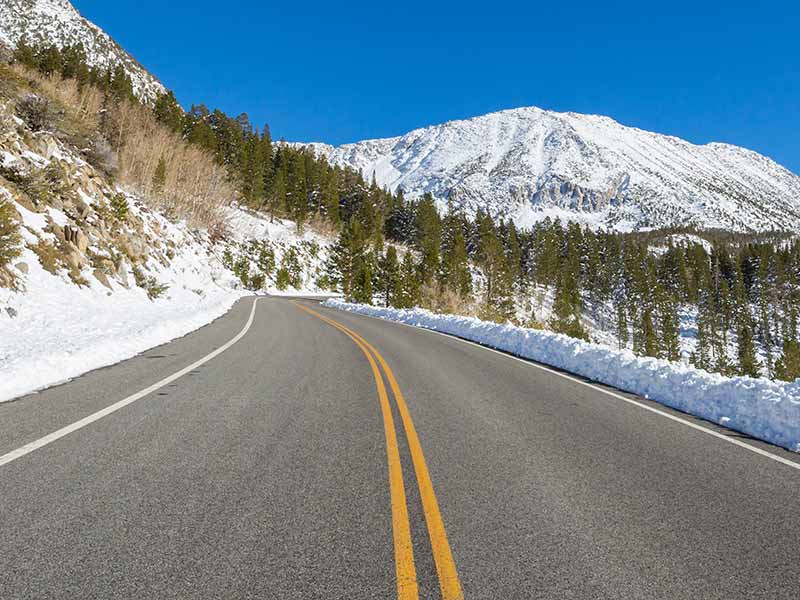
When to Use and Not to Use Tire Chains
Knowing when to use snow chains and when to skip them helps keep you safe on the road while avoiding unnecessary damage to both the chains and the road surface. Let’s discuss situations when snow chains are helpful and when they might not be the best choice.
Suitable Conditions for Using Snow Chains
Snow chains work wonders in certain conditions:
- Snowy Roads: When roads are covered in snow or slush, using snow chains can provide better traction and control, especially when driving uphill or on curves.
- Icy Surfaces: Chains also help on icy roads by biting into the ice, offering more grip than regular tires.
Inappropriate Conditions for Using Snow Chains
However, there are times when using snow chains isn’t a good idea:
- Dry Roads: When roads are dry or only slightly snowy, using snow chains can damage both the chains and the road. It can also make your driving less safe.
- High Speeds: Driving too fast with snow chains can be dangerous. They’re meant for slower speeds to maintain control.
- Studded Tires: If your tires already have metal studs designed for icy roads, adding snow chains might not be necessary. Studded tires often work well without extra chains.
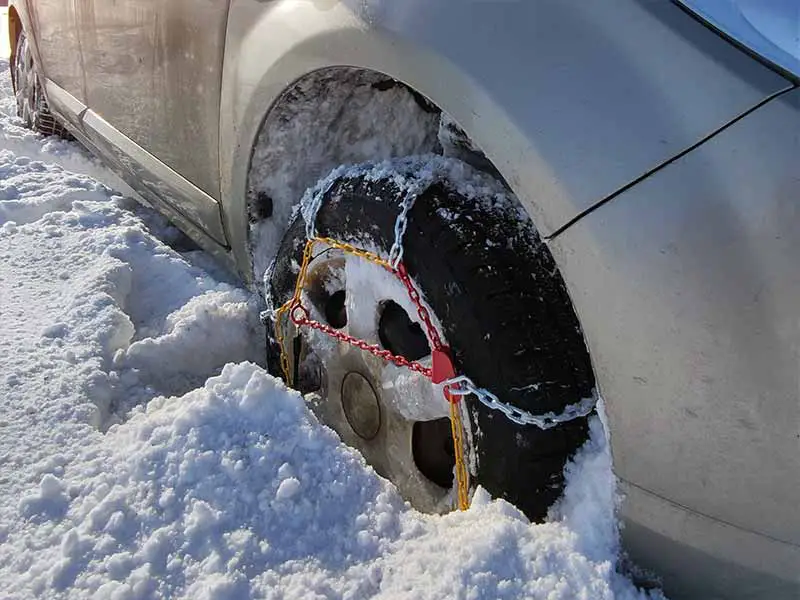
Safety Tips and Considerations for Driving with Snow Chains
Here are some important tips and things I suggest to remember when you’re out on wintry roads with snow chains on your tires.
Checking Chains for Proper Installation
Before hitting the road, ensure the snow chains are installed correctly:
- Inspect Installation: Look over each chain to make sure it’s sitting properly on the tire and hasn’t slipped or moved out of place.
- Check Tension: Ensure the chains are snug but not too tight. They should have a little give but remain securely fastened.
Adjusting Chains if They Come Loose
Sometimes, chains can loosen during driving. Here’s what to do:
- Stop Safely: If you feel or hear chains rattling or notice them becoming loose, find a safe spot to stop.
- Re-Tighten: Re-adjust the chains and make sure they’re properly tightened before continuing your journey.
Driving Safely with Snow Chains
Snow chains change how your car handles, so drive carefully:
- Reduce Speed: Drive at a slower pace than usual. Snow chains are best suited for slower speeds to maintain control.
- Avoid Sudden Moves: Be gentle with steering, acceleration, and braking to prevent skidding or loss of control.
Removing Chains When No Longer Needed
Once road conditions improve, it’s important to take off the chains:
- Find a Safe Spot: Stop in a safe area away from traffic to remove the chains.
- Store Chains Properly: Store the chains in your vehicle or in their carrying case for future use.
Always Be Prepared
Remember these additional tips for using snow chains:
- Practice: It’s a good idea to practice installing chains in good weather, so you’re familiar with the process before you need them in an emergency.
- Plan Ahead: Always check weather forecasts before traveling and consider if snow chains will be necessary.
- Carry Chains With You: If you live in an area that experiences harsh winters, it’s always a good idea to keep tire chains in your car or truck during the winter months.
Resources
Below are some links you may find helpful when learning about tires:
- How to put snow chains on your tires – Family Handyman
- How to: Put on snow chains and drive safely – Les Schwab
Final Thoughts
By understanding your vehicle, choosing the right chains, and following the step-by-step installation guide, you’re equipped to handle adverse weather conditions with confidence. Remember, safety is paramount; follow the suggested guidelines, stay cautious on the road, and always prioritize your well-being and that of others.
Snow chains serve as a crucial tool in your winter driving arsenal, enhancing traction and control when roads turn icy or snowy. By using them correctly and knowing when they’re necessary, you’re ensuring a safer journey during challenging weather conditions.
Good luck and happy motoring.




